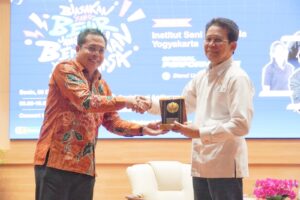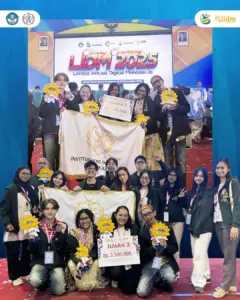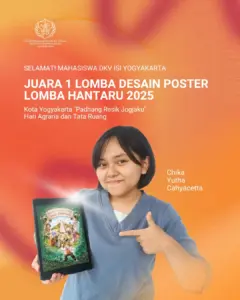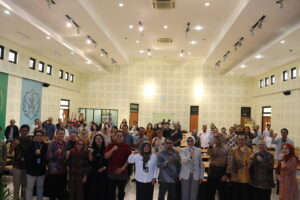On Monday, June 24, 2019 at the RJ Katamsi Gallery, the opening of the XXXV-Lustrum VII Anniversary Fine Art Exhibition of ISI Yogyakarta was held which was opened by the Rector of ISI Yogyakarta with the Chairperson I Gede Arya Sucitra, S.Sn., M.A., and curators Bambang Witjaksono, M.Sn., Terra Bajraghosa, M.Sn., Dony Arsetyasmoro, S.Sn., M.Ds., Budi Hartono, S. Sn., M. Sn. The exhibition will run from June 24 - July 03, 2019.
This year, the main theme of ISI Yogyakarta's 7th Lustrum commemoration is "Artificial Intelligence in Art in the Era of Industrial Revolution 4.0". Explained in detail the purpose of the theme is to see the achievements that have occurred for five years and the need for reflection towards the era of the industrial revolution 4.0. The industrial revolution 4.0 is an integration between the online internet world and the world of business or production in an industry that can support all fields, one of which is in the academic world.
Fine Art Exhibition Dies Natalis XXXV/Lustrum VII of Institut Seni Indonesia Yogyakarta 2019 is "Fine Arts in the Era of Industrial Revolution 4.0" this time is quite special. The exhibition was attended by alumni of each programs, students, and also lecturers within the Faculty of Fine Arts, Institut Seni Indonesia Yogyakarta. This exhibition attended by 27 Alumni and Lecturers, 111 Students from the Faculty of Fine Arts, ISI Yogyakarta. Yogyakarta.
In the global art world, the aspect of technology, even what is now called the industrial revolution 4.0, is very closely attached to the pattern, method, process and visual appearance. What makes this event different is that the theme of the industrial revolution 4.0 is associated with the academic art world. In fact, academic art systematically still relies on modern art patterns. The field of design, especially interior design, can be understood as one of the products of the industrial revolution. The development of the times has an impact on the field of interior design because it brings up different materials and technologies that continue to be responded to by designers. Interior design, which used to be limited to decorating a room, has now developed into a specific specialist/expert that requires complex expertise ranging from knowledge of materials, technology and lifestyle trends that are developing in society. Technology makes everything change quickly according to the wishes of its users, including public tastes that can change quickly due to the influence of the swift flow of information, one of which is through social media. The existence of social media makes a place for self-existence that can be done by anyone, anytime and anywhere, including by uploading a place with an attractive and unique design, so that the term place/location appears. Instagramable. Interior design professionals are required to work creatively, innovatively and multidisciplinarily to utilize technological disruption to create a better built environment. The multiplicity of the industrial revolution 4.0 makes the boundaries between the digital, physical and biological worlds increasingly thin. All activities centered on the incorporation of automation and cyber technology have changed the paradigm of society, especially the millennial generation.
In Interior Design as a field of applied science, a designer's sensitivity to the diversity of consumer / market demands has become a necessity so that his work can continue to be actual in society. The era of the industrial revolution 4.0 can be agreed to have given rise to different consumer characteristics with different demands. However, it cannot be ignored that there are still many parts of our society that have not been touched by this industrial revolution, especially marginalized communities who do not have access to technology due to economic factors. Therefore, interior designers are required to remain flexible and accommodating in responding to the changing needs of society without neglecting their role to continue serving all people who may still be in the industrial revolution zone 3.0 or even 2.0, because keep in mind that the industrial revolution arises out of necessity not for show.
Teddy Rahardianto, an interior and furniture designer now based in Osaka, Japan showcases his lobby design project. Burbank Suites Apartments in Cikarang Jakarta, which has a modern minimalist style in line with the trends that urbanites are interested in today. The decision to live in a big city makes Teddy easily translate elegant design languages to be applied to his designs. While Puspa Candrajati through her company Kinanthi Royal Decor showcases a mini photoboothto wedding decoration. His work has branding strong because of its consistent use of natural materials and outdoor settings (outdoor) with a natural concept but still has an exclusive and elegant impression.
Students who The students who chose the 'internet route' also struggled to present the excellence of their work, with part of the final project spent studying the with part of the final project period spent learning the system and technical and technicalities of the medium, in addition to preparing the visual design. Gadgets certain items were also presented by students in the final project exhibition to support this, either by buying, borrowing or renting. buying, borrowing, or renting. The selection of the big theme of the anniversary which about artificial intelligence sparked a thought to look back at works that at least use the internet in their distribution. works that at least use the internet in their distribution. Very unfortunate, but this is the reality, the works of nginternet It has multiple levels of difficulty to displayed in an art exhibition. The basic and most essential layer layer is our inability as curators to provide gadgets to showcase the work. Or the incompatibility of software that sometimes when displayed is only trial, and has expired. On the work side, sometimes only the beta version is available. beta version. Another alternative is to display the offline version, or a printed version of the presentation in the form of mind-mapping. presentations in the form of printed mind-mappings, but this will also erode the will erode the user experience-her.
In the Visual Communication Design Study Program Faculty of Fine Arts ISI Yogyakarta, in the era of the industrial revolution 4.0 today, there have been many students' Final Project works that refer to the Internet of Thingsor at least have a purpose in the system because the real focus is on the visual design. the visual display design. In the early 2000s, digital-based design works such as games, short videos, and interactive tutorials were digital-based design works such as games, short videos, and interactive tutorials, were designed to be displayed on computer screens and distributed through the physical form of compact discs. disk. A decade later, the idea of distribution through physical mediums began to shifted to distribution through the internet. What is being distributed was no longer limited to what could only be thought of as appearing on a computer screen, as in the era of smartphones screen (computer), because in this era of smartphones, almost everything appears through the screen. And these things, the contents that are distributed, are definitely visual. are definitely visual. This visual nature, or more appropriately called 'information visualization' in the realm of industry 4.0, does not only decorating or decorating a content, but also makes it easier to use the the content itself by remembering that at this time the fulfillment of various modern human needs and needs and necessities of modern humans are supported by internet technology. internet.
Art education, especially craft education, is always directly proportional to the development of technology. with the development of technology. Proficiency and craftsmanship in the praxis of craft craftsmanship is vital in creating craft products. However, However, relying on hand skills alone is not enough to produce an innovative an innovative craft product that has high value. The existence of technology in the industrial revolution 4.0 can be utilized by craftsmen to search for information to explore and refine their products. to find information in exploring and perfecting ideas and ideas without having to struggle and of course without having to struggle and certainly minimize the production costs incurred. incurred. However, will artificial intelligence eliminate artificial intelligence? practices in the field of craftsmanship and be eroded by the times? time?
Indonesia's diversity and abundance of natural resources, human resources, art and cultural heritage are invaluable assets for the nation. In fact, crafts and creative processes in the era of artificial intelligence do not always come with the packaging of industrialization practices alone. Craft art is present and attached to traditional societies, not separated from the lifestyle, customs where they were born and live. Crafts can also be born from imaginary things, spirituality, contemplation, and so on. When the skill of the hand is able to conquer the canting, playing dynamic lines full of harmony on a piece of cloth, and repeated after the coloring process, is a creative process that has not been replaced by mechanical machines. However, on the one hand, technological advances, such as cellular phones (cell phone), It is also beneficial for the employees. With the advent of mobile phones, traditional marketing methods have been abandoned. Clerks can conduct transactions with their clients only through cell phones, without having to meet face-to-face. Similarly, for banking matters, for example, employees can use banking applications found on their cell phones.
The tradition of inviting alumni to play a role in event-event campus events, such as Dies Natalis is something important and needs to be preserved because those outside the campus are milestones, the face of all of us in the discourse. art world craft art. Their artistic achievements are always seen, noted and awaited, both nationally and internationally. Alumni, especially Craft Art, are expected to be able to display their creative ideas after leaving the lecture bench. Their off-campus experience, research-based work patterns are part of their intimate work procedures, so that they will be seen and reflected in every work displayed in the exhibition later. The Art Craft alumni who participated on this occasion included Endang Lestari, Carolina Rika Winata, Wahyu Hidayat (Gogon), Rudi Hendriatno, and Apri Susanto, who represented ceramic craft, textile craft, metal craft, and wood craft. It was only fitting for them to participate in this exhibition. It is undeniable that their work has always been update with creative ideas, dedication, and hard work to create innovative works.












